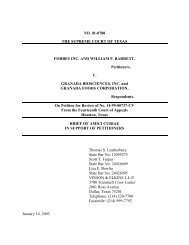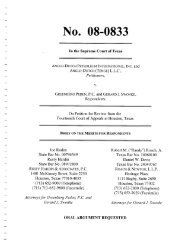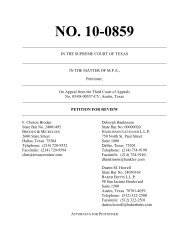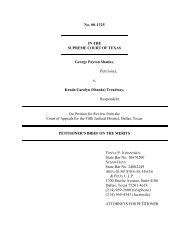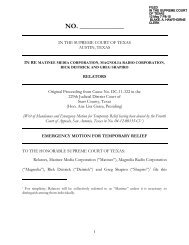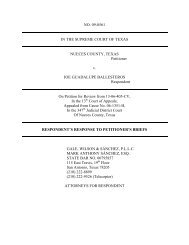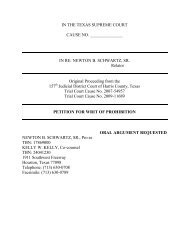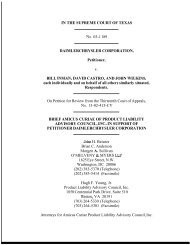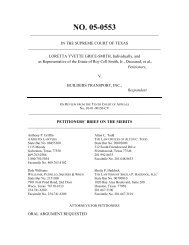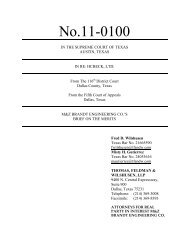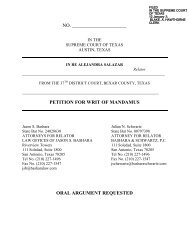Petition for Writ of Mandamus - Filed - Supreme Court of Texas
Petition for Writ of Mandamus - Filed - Supreme Court of Texas
Petition for Writ of Mandamus - Filed - Supreme Court of Texas
Create successful ePaper yourself
Turn your PDF publications into a flip-book with our unique Google optimized e-Paper software.
entity at the address listed on the report and shall be deemed<br />
sufficient and adequate notice <strong>of</strong> such liability to each<br />
member <strong>of</strong> the combined group. Separate notice to each<br />
member shall not be required.<br />
Tiered Partnership Election<br />
A "tiered partnership arrangement" means an ownership<br />
structure in which any <strong>of</strong> the interests in one taxable entity<br />
treated as a partnership or an S corporation <strong>for</strong> federal<br />
income tax purposes (a "lower tier entity") are owned by<br />
one or more other taxable entities (an "upper tier entity"). A<br />
tiered partnership arrangement may have two or more tiers.<br />
The tiered partnership election, under Sec.171.1015 Tax<br />
Code , is not mandatory; it is a filing option <strong>for</strong> entities in a<br />
tiered partnership arrangement.<br />
The tiered partnership election is not an alternative to<br />
combined reporting. Combined reporting is mandatory <strong>for</strong><br />
taxable entities that meet the ownership and unitary criteria.<br />
There<strong>for</strong>e, the tiered partnership election is not allowed if<br />
the lower tier entity is included in a combined group.<br />
Additionally, the tiered partnership election is not allowed if<br />
the lower tier entity, be<strong>for</strong>e passing total revenue to the upper<br />
tier entities, has $1,030,000 or less in annualized total<br />
revenue or owes less than $1,000 in tax.<br />
The tiered partnership election allows the lower tier entity<br />
to pass its total revenue to its upper tier entities. The upper<br />
tier entities then report this passed revenue with their own<br />
total revenue. It is important to note that this election does<br />
not allow the lower tier entity to pass its deductions <strong>for</strong> cost<br />
<strong>of</strong> goods sold or compensation to the upper tier entities.<br />
The requirements <strong>for</strong> filing under the tiered partnership<br />
election are:<br />
• All taxable entities involved in the tiered partnership election<br />
must file a franchise tax report, a Public In<strong>for</strong>mation Report<br />
(Form 05-102) or Ownership In<strong>for</strong>mation Report (Form 05-<br />
167), and the Tiered Partnership Report (Form 05-175).<br />
• Both the upper and the lower tier entities must blacken<br />
the tiered partnership election circle on their tax reports.<br />
• Total revenue may be passed only to upper tier entities<br />
that are subject to the <strong>Texas</strong> franchise tax.<br />
• Total revenue must be passed to upper tier taxable entities<br />
based on ownership percentage.<br />
• Deductions (COGS or compensation) may not be passed<br />
to upper tier entities.<br />
• The upper and lower tier entities may use the EZ<br />
Computation (Form 05-169) only if the lower tier entity has<br />
$10 million or less in annualized total revenue be<strong>for</strong>e total<br />
revenue is passed to the upper tier entities.<br />
• The upper tier entities are not eligible to file a No Tax Due<br />
In<strong>for</strong>mation Report (Form 05-163).<br />
Both the upper and lower tier entities will owe any amount<br />
<strong>of</strong> tax that is calculated as due even if the amount is less<br />
than $1,000 or annualized total revenue after the tiered<br />
partnership election is less than $1,030,000.<br />
If the upper and lower tier entities have different accounting<br />
periods, the upper tier entity must allocate the total revenue<br />
reported from the lower tier entity to the accounting period<br />
on which the upper tier entity's report is based.<br />
Credits<br />
2008 Temporary Credit <strong>for</strong> Business Loss Carry<strong>for</strong>wards<br />
A taxable entity is eligible <strong>for</strong> the credit if the entity was, on<br />
May 1, 2006, subject to the franchise tax. The credit is based<br />
on business loss carry<strong>for</strong>wards that were created on the 2003<br />
and subsequent franchise tax reports that were not exhausted<br />
or expired on a report due be<strong>for</strong>e Jan. 1, 2008. Business<br />
loss carry<strong>for</strong>wards must have been used to <strong>of</strong>fset any positive<br />
amount <strong>of</strong> earned surplus, even in years when no tax was<br />
due or the tax due was based on taxable capital.<br />
Each eligible taxable entity must have preserved its right to<br />
take the credit on or be<strong>for</strong>e the due date <strong>of</strong> its 2008 report.<br />
The taxable entity (including combined groups) must elect to<br />
claim the credit on or be<strong>for</strong>e the original or extended due date<br />
<strong>of</strong> the report on which the credit will be taken. The election is<br />
made by actually taking the credit on a completed report <strong>for</strong>m<br />
filed on or be<strong>for</strong>e the original or extended due date.<br />
A taxable entity that is a combined group is allowed to take a<br />
credit <strong>for</strong> eligible members <strong>of</strong> the combined group (i,e., the<br />
member was subject to the franchise tax on May 1, 2006,<br />
and preserved the right to take the credit). If a member <strong>of</strong> a<br />
combined group changes combined groups the business loss<br />
carry<strong>for</strong>ward <strong>of</strong> that member will no longer be included in the<br />
temporary credit calculation <strong>of</strong> the group and the related share<br />
<strong>of</strong> any temporary credit carried over from a previous year is<br />
lost to the group. There is no proration <strong>for</strong> a partial year.<br />
See Rule 3.594 <strong>for</strong> additional in<strong>for</strong>mation regarding this credit.<br />
Economic Development Credits<br />
A taxable entity that established a research and<br />
development or job creation credit on a franchise tax report<br />
originally due prior to Jan. 1, 2008, may claim any unused<br />
credit carried <strong>for</strong>ward to <strong>of</strong>fset the tax on margin.<br />
A taxable entity that established a capital investment credit<br />
on a franchise tax report originally due prior to Jan. 1, 2008,<br />
may claim any unused installments and credit carried<br />
<strong>for</strong>ward to <strong>of</strong>fset the tax on margin.<br />
Note: An enterprise project that established a capital investment<br />
credit on a 2008 franchise tax report may carry <strong>for</strong>ward any<br />
unused credit to <strong>of</strong>fset the tax on margin. See Rule 3.593<br />
<strong>for</strong> additional in<strong>for</strong>mation.<br />
Amended Reports<br />
If an entity needs to amend a report, it must file all pages <strong>of</strong><br />
the report (as originally filed) along with a cover letter<br />
explaining the reason <strong>for</strong> the amendment. The entity must<br />
write "AMENDED" on the top <strong>of</strong> the report and submit<br />
supporting documentation. See Rule 3.584 <strong>for</strong> additional<br />
in<strong>for</strong>mation.<br />
9




